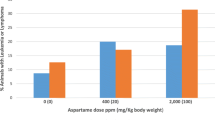Summary
Alpha-fetoprotein (AFP)-producing capacity and some other properties of human hepatoma cell lines treated with chemotherapeutic agents, such as mitomycin C, Adriamycin, cisplatinum, and 5-fluorouracil were investigated. In the case of hepatoma cells that can be grown in culture following treatment with chemotherapeutic agents, their AFP-producing capacity was almost equal to that of untreated control cells with a few exceptions. On the other hand, in the case of similarly treated hepatoma cells that cannot be grown in culture, their AFP-producing capacity was quite different from that of untreated control cells. Under these conditions chromosomal and morphological aberrations were also observed in the treated cells. The present study shows that AFP-producing capacity of hepatoma cells can be changed by chemotherapeutic agents, probably through chromosomal mutation.
Similar content being viewed by others
References
Bassendine MF, Wright NA, Thomas HC, Sherlock S (1983) Growth characteristics of α-foetoprotein-secreting human hepatocellular carcinoma in athymic (nude) mice. Clin Sci 64:643–648
Bishun NP (1971) The cytogenetic effect of cyclophosphamide on a Burkitt tumor cell line (EB 4) in vitro. Mutat Res 11:258–260
Conen PE, Lansky GS (1961) Chromosomal damage during nitrogen mustard therapy. A case report. Br Med J 2:1055–1057
Curtin NJ, Harris AL, James OFW, Bassendine MF (1986) Inhibition of the growth of human hepatocellular carcinoma in vitro and in athymic mice by a quinazoline inhibitor of thymidylate synthase. CB3717. Br J Cancer 53:361–368
Doi I (1976) Establishment of a cell line and its clonal sublines from a patient with hepatoblastoma. Gann 67:1–10
Elves MW, Buttoo AS, Israels MC, Wilkinson JF (1963) Chromosome changes caused by 6-azauridine during treatment of acute myeloblastic leukemia. Br Med J 1:156–159
Johnson PJ, Williams R, Thomas H, Sherlock S, Murray-Lyon IM (1978) Induction of remission in hepatocellular carcinoma with doxorubicin. Lancet 1:1006–1009
Johnson PJ, Williams R (1980) Serum alpha-fetoprotein estimations and doubling time in hepatocellular carcinoma: influence of therapy and possible value in early detection. J Natl Cancer Inst 64:1329–1332
Matsumoto Y, Suzuki T, Ono H, Nakase A, Honjo I (1974) Response of alpha-fetoprotein to chemotherapy in patients with hepatomas. Cancer 34:1602–1606
McIntire KR, Vogel CL, Primack A, Waldmann TA, Kyalwazi SK (1976) Effect of surgical and chemotherapeutic treatment on alpha-fetoprotein levels in patients with hepatocellular carcinoma. Cancer 37:677–683
Muraoka A, Tokiwa T, Sato J (1989) Effects of chemotherapeutic agents on alpha-fetoprotein secretion and growth of human hepatoma cell lines. Br J Cancer 59:569–572
Nagasue N, Inokuchi K, Kobayashi M, Saku M (1977) Serum alpha-fetoprotein levels after hepatic artery ligation and postoperative chemotherapy. Cancer 40:615–618
Nakabayashi H, Taketa K, Miyano K, Yamane T, Sato J (1982) Growth of human hepatoma cell lines with differentiated functions in chemically defined medium. Cancer Res 42:3858–3863
Pritchard J, da Cunha A, Cornbleet MA, Carter CJ (1982) Alpha feto (αFP) monitoring of response to adriamycin in hepatoblastoma. J Pediatr Surg 17:429–430
Rothfels KH, Siminovitch L (1958) An air-drying technique for flattening chromosomes in mammalian cells grown in vitro. Stain Technol 33:73–77
Tokiwa T, Hishinuma T, Degawa M, Hashimoto Y, Sato J (1986) Malignant transformation of rat liver cells byN-benzoyloxy-3′-methyl aminoazobenzene and its related compound. J Nat Cancer Inst 76:95–99
Tokiwa T, Kusaka Y, Muraoka A, Sato J (1989) Effects of serum and serum-derived factors on the growth and production of α-fetoprotein and albumin by human hepatoma cell lines. Cell Biol Toxicol 5:207–216
Tokiwa T, Miyagiwa M, Kusaka Y, Muraoka A, Sato J (1988) Effects of various substrates on human hepatoblastoma and hepatoma cell culture. Cell Biol Int Rep 12:131–142
Author information
Authors and Affiliations
Rights and permissions
About this article
Cite this article
Muraoka, A., Tokiwa, T. & Sato, J. Alpha-fetoprotein-producing capacity, chromosomal and morphological properties in human hepatoma cells treated with various chemotherapeutic agents. Res. Exp. Med. 189, 409–419 (1989). https://doi.org/10.1007/BF01855008
Received:
Accepted:
Issue Date:
DOI: https://doi.org/10.1007/BF01855008




